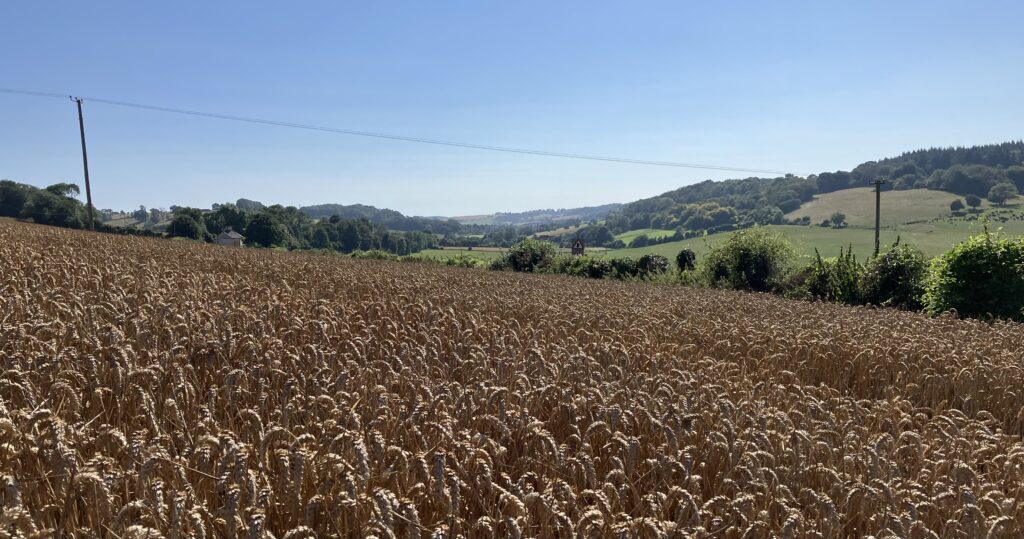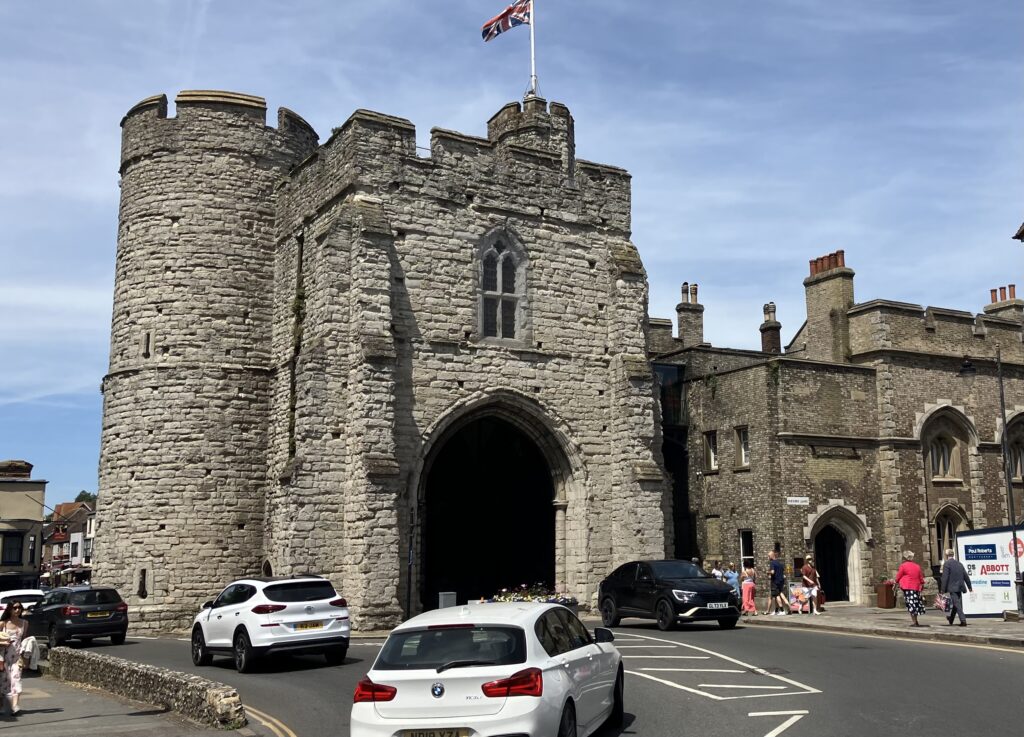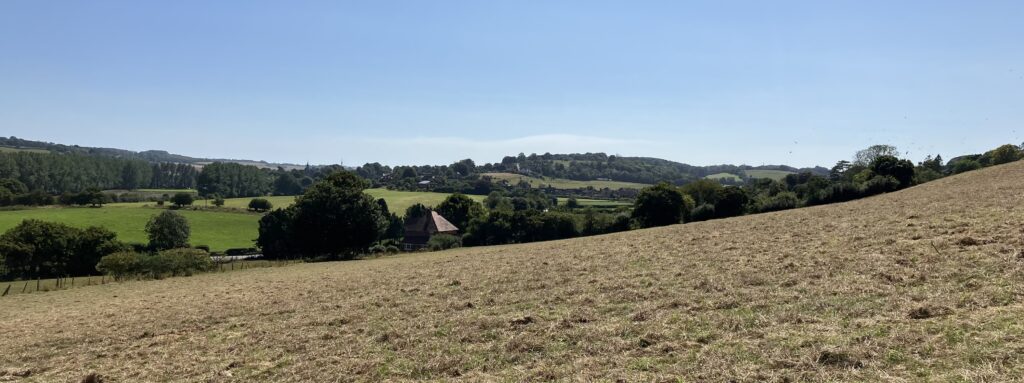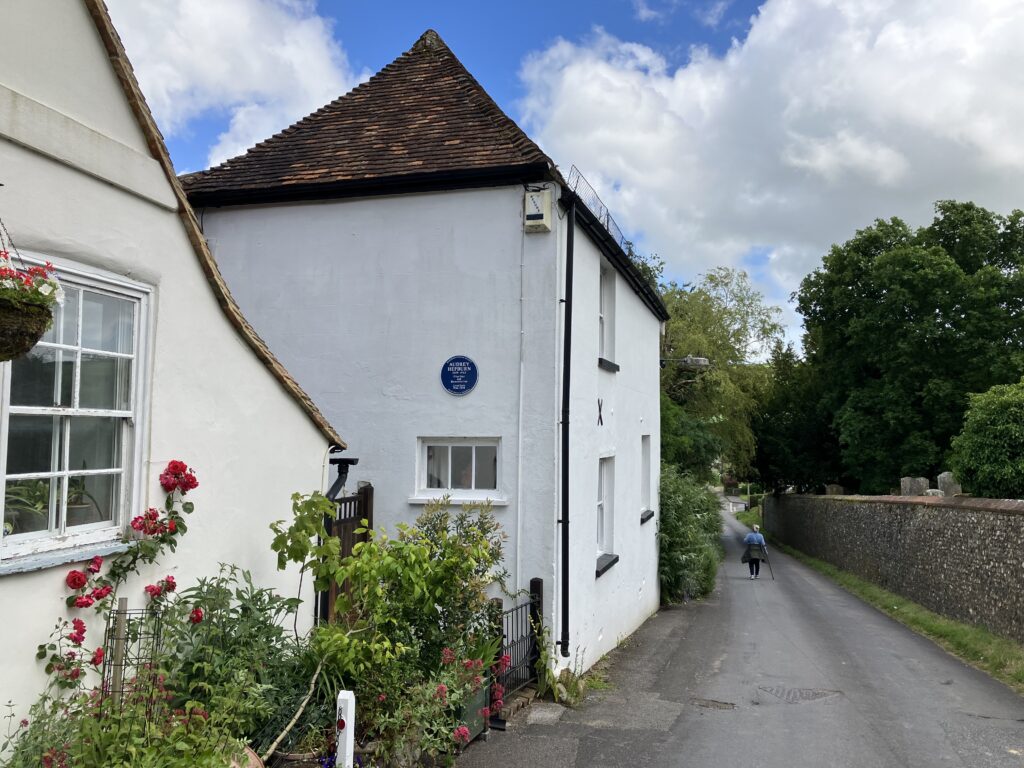On this day, 196 years ago, two dozen men gathered at a farm in the Elham Valley hamlet of Wingmore and systematically set about destroying a threshing machine.
The following evening, the gang moved on to the nearby farm at Grimsacre and broke the machine there. Three days later, on the evening of the 28 August 1830, the emboldened saboteurs struck again, destroying three more threshing machines on isolated farms on the hills above the valley.

Awaiting the harvest in the wheat fields above the Elham Valley today
Over the next month, around a dozen more threshing machines were destroyed over a wider area of east Kent. Towards the end of September, when the word was out, the machine-breakers’ tactics changed. They sent warning letters to farmers informing them that their machines would be destroyed, and advised them to move their property to open fields rather than attempt to secure them in barns that would only be burnt down. These letters were signed “Swing.”
The protests associated with Captain Swing quickly spread across Kent and the whole of southern England with hundreds of incidents of machine breaking, arson, threatening letters and open protests recorded in Kent, Surrey, Sussex, Hampshire, Dorset, and further afield, for several months right up until the end of December. The Swing protests may not have been as intense or dramatic as the Great Peasants Revolt of 1381 (which also originated in Kent) but they involved more people, lasted longer, extended over a wider area, and arguably had a greater social impact.
The protests were obviously not just about threshing machines but rather social justice and the welfare of the poor. These new contraptions had been introduced on many larger farms across England in the early 19th century, and were soon recognised by rural labourers and smaller farmers as an existential threat – a symbol of the breakdown of traditional rural society. Threshing machines greatly reduced the need for manual labour at harvest time, and the unemployment they created placed an even greater burden on the local parish, which was obligated to provide poor relief to villagers in times of need.
The crisis was exacerbated by the economic recession and the return of demobilised soldiers to the land after the Napoleonic Wars. By the mid-1820s, the situation was so bad that many families were left to starve in their homesteads. The only way rural labourers could obtain any monetary relief was by working on road repair gangs for subsistence wages.
The radical politician and propagandist, William Cobbett, described the appalling living conditions of rural workers in detail in his famous survey of southern England, Rural Rides, and, in 1830, he explicitly warned farmers and landowners that the countryside was ripe for revolution:
Your labourers hate you as they hate toads and adders. They regard you as their deadly enemies, as those who robbed them of their food and raiment, and who trample on them and insult them in their state of weakness, and they detest you accordingly.
There had been numerous isolated protests against landowners before the 24 August attack but it took the organizational skills and determination of a Kentish smuggling gang to bring the movement to the next level, and kick-start a nationwide rebellion. The revolutionary actors of the Elham Valley included former members of the notorious smuggling gang, the Blues, based in nearby Aldington on the fringes of Romney Marsh. The Blues disbanded after the arrest of their leader in 1826, leaving its cohort unemployed and restless. But in the summer of 1830, it seems that they got the band back together again.
The newly formed Elham Gang was able to launch a sustained campaign of guerrilla raids and intimidation against landowners, and generated considerable public support in the process. Even after being captured, the seven members of the gang who were eventually tried at the East Quarter Sessions on 22 October, were only sentenced to four days in Canterbury gaol. The light sentence reflected a general feeling that the gang’s actions were justified. Indeed, those who dared criticise the gang often received incendiary threats in return.

Canterbury’s Westgate Tower and the Pound Lane Gaol, completed in the 1820s, just in time to welcome the Elham Gang for their brief stay
Not all the subsequent Swing protests were as well organized as those by the Elham Gang but the initial protests certainly established the pattern for what followed. Such was the underlying discontent in the rural economy at the time, that any kind of protest action was likely to inspire others. And it was not just in rural areas where local workers were taking action. Throughout the 1820s, Kent was an important centre of trade union organising among the building trades, rope and paper makers etc., and these workers were taking collective action too.
The Swing protests sent shock waves through the political (landowning) establishment, and forced concessions from farmers in terms of higher wages. However, the longer-term response was one of repression.
The newly enfranchised middle-class electors of England, demanded that the government take sustained action to prevent or at least forestall further uprisings in the future. But rather than help impoverished labourers, as advocated by Cobbett and others, parliament focused on the contentious issue of poor relief. The current system, it was claimed, encouraged a sense of entitlement among the peasantry, and this was seen as a major contributory factor in rural unrest. The 1834 Poor Law Amendment Act would put an end to that. It established a centralised system of poor relief based on prison-like work houses, designed to act as a deterrent to the work-shy and indolent, and allow the free market to determine wage levels without any paternalistic subsidies from the local parish.
As I noted in my earlier blog on rural workhouses, the local gentry in Kent were quick to act and build imposing brick workhouses designed to discourage any malingerers from seeking a residential upgrade. The tough workhouse regime introduced in the 1830s kept rural labour under tight control, and stayed in place for nearly one hundred years when responsibility for housing and social welfare was taken over by local councils.
However, Swing did have some positive impacts for the rural working class. It highlighted the power of collective action, but also the need for better organization. Just four years after Swing, a small group of rural workers in the Dorset village of Tolpuddle created a trade union to fight for better pay. Local landowners had them arrested and sentenced to seven years’ transportation on the pretext of swearing an illegal oath. The persecution of the Tolpuddle Martyrs led to mass protests by workers across England and forced the government to commute their sentences. They returned home to a hero’s welcome four years later.

Looking down the valley from Grimsacre towards the village of Elham
Tolpuddle is rightly proud of its history and its contribution to the labour movement in England but back in the Elham Valley, there is currently little to commemorate the Elham Gang or the Swing protests. That, I am glad to say, is about to change. The Elham Historical Society is planning to commemorate the bi-centennial of Swing with a series of events in the summer of 2030, and install a guide to the protests in the village square. Since several descendants of the original gang still live in the village, it seems only fitting that their ancestors should be recognised.
There is even a link to Swing with Elham’s most famous former resident, Audrey Hepburn, who lived in the village for three years as child prior to the Second World War. Local historian Derek Boughton tells me that the cottage she lived in was previously the home of the leader of the Elham Gang, Henry Read. There is already a blue plaque for Audrey Hepburn on the cottage (see below), so perhaps the Elham Gang could get one too.

I like to think that Audrey Hepburn, who in later life was an UNICEF ambassador dedicated to the eradication of poverty, might have recognised a kindred spirit in the Elham Gang. She might not have approved of their methods but hopefully she would have appreciated that they did more than most to improve the lives of local community.
Recommended reading
Carl J. Griffin, The Rural War: Captain Swing and the Politics of Protest, Manchester University Press, 2012.
Eric. J Hobsbawm and George F. E Rudé, Captain Swing, London: Phoenix Press, 2001.
Paul Hastings, Radical Movements and Workers’ Protests to c.1850, in Frederick Lansberry (Ed), Government and Politics in Kent, 1640-1914, Boydell Press, 2001.
Juliet Barker, 1381: The Year of the Peasants’ Revolt, Harvard University Press, 2014.
William Cobbett, Rural Rides, serialised in the Political Register 1822-26.